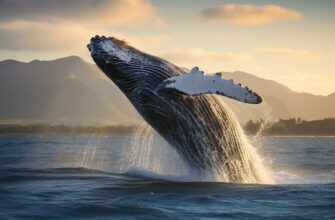Blue whales are the largest creatures on Earth, weighing in at over 200,000 pounds and measuring up to 100 feet long. With their immense size, one might assume that these creatures are fierce and aggressive. However, this is a common misconception. In reality, blue whales are known for their gentle nature and peaceful temperament, making them some of the most majestic creatures of the sea.
Despite the fact that blue whales are massive in size, they are purely plankton feeders, subsisting on krill and other small organisms. They do not possess any teeth, and instead, have plates in their mouths which they use to filter and strain their food from the water. This makes them particularly docile and non-threatening creatures.
- Key Takeaways:
- Characteristics of Blue Whales
- Physical Characteristics
- Social Behavior
- Diet
- Behavior of Blue Whales
- Feeding behavior
- Migratory patterns
- Blue Whales and Human Interactions
- Conservation Efforts and Protection of Blue Whales
- The Gentle Giants of the Sea
- FAQ
- Q: Are blue whales gentle?
- Q: What are the characteristics of blue whales?
- Q: How do blue whales behave?
- Q: How do blue whales interact with humans?
- Q: What conservation efforts are in place to protect blue whales?
- Q: Why are blue whales considered the gentle giants of the sea?
Key Takeaways:
- Blue whales are the largest creatures on Earth, but this does not mean they are aggressive.
- Despite their size, blue whales are known for their peaceful temperament.
- Blue whales are plankton feeders and do not possess teeth, making them harmless to humans.
Characteristics of Blue Whales
Blue whales are known for their peaceful nature and gentle temperament. These giants of the sea are the largest mammals on earth, with an average length of 80 feet and a weight of approximately 200,000 pounds.
Despite their massive size, blue whales are graceful swimmers and natural acrobats. They are capable of diving to depths of up to 500 meters, holding their breath for up to 30 minutes, and swimming at speeds of up to 30 miles per hour.
Physical Characteristics
The blue whale’s body is long and streamlined, with a narrow, pointed head and a broad, flat tail. Their skin is a bluish-gray color and is covered in a layer of oil that helps to reduce friction in the water.
Their most distinctive feature is their enormous size, which is evident in their massive, barrel-shaped bodies and their long, slender flippers.
Social Behavior
Blue whales are known to be social creatures, often traveling in small groups known as pods. In these pods, they communicate with each other using a range of sounds, including grunts, moans, and whistles.
They are also known to be curious creatures, sometimes approaching boats and divers out of curiosity. However, it is important to note that they are still wild animals and should be treated with caution and respect.
Diet
Blue whales are baleen whales, which means they filter their food through bristle-like structures in their mouths called baleen plates. Their diet consists mainly of small shrimp-like creatures called krill, which they consume in massive quantities of up to 4 tons per day during feeding season.
Overall, the peaceful nature and friendly demeanor of blue whales make them one of the most fascinating creatures in the sea. However, it is important to continue conservation efforts to protect them from human interactions and other threats to their survival.
Behavior of Blue Whales
Blue whales are known for their friendly demeanor and docile nature. They are often spotted swimming near boats and even approaching humans in the water. In fact, blue whales have been known to interact with humans, showing curiosity rather than aggression.
One of the most remarkable things about blue whales is their vocalizations. They produce a variety of sounds, including songs that can be heard for miles underwater. These songs are not just random noise, but have a specific pattern and purpose. Scientists believe they are used for communication and may play a role in mating.
Feeding behavior
Blue whales are filter feeders, consuming huge quantities of krill and small fish through baleen plates in their mouths. Despite their enormous size, blue whales are surprisingly graceful and efficient when feeding. They use a technique called lunge feeding, where they open their mouths wide and engulf large amounts of water and prey in one go.
After swallowing their prey, blue whales use their baleen plates to filter out the water, leaving only food behind. This process can take a few seconds to several minutes, depending on the size of the prey.
Migratory patterns
Blue whales are known for their long-distance migrations. They spend their summers in high-latitude feeding grounds, such as the polar regions, and migrate to warmer waters near the equator during the winter. These migrations can cover thousands of miles and are necessary for their survival.
Despite their peaceful nature, blue whales face several threats, including climate change, pollution, and hunting. It is important that we work to protect these magnificent creatures and their habitats to ensure their survival for generations to come.
Blue Whales and Human Interactions
Despite their massive size, blue whales have a non-aggressive behavior towards humans. In fact, their interactions with people are often peaceful, making them one of the most harmless creatures in the sea.
Although blue whales were hunted to near extinction in the 20th century, today, the conservation efforts have helped protect their population. However, human activities still pose a threat to these gentle giants.
One of the biggest dangers to blue whales is accidental collisions with ships. As a result, shipping lanes have been shifted, and speed limits have been imposed to reduce the risk of such collisions.
Another threat to blue whales is noise pollution from shipping and oil drilling. These sounds can interfere with their communication and navigation, disrupting their feeding and breeding patterns.
Fortunately, there are ongoing efforts to protect blue whales from these threats. The International Whaling Commission has placed a ban on commercial whaling, and many countries have established marine protected areas where these gentle giants can thrive.
It is important to continue to support these conservation efforts to ensure the safety and protection of blue whales for future generations.
Conservation Efforts and Protection of Blue Whales
As gentle giants of the sea, blue whales require our protection and conservation efforts. These efforts aim to preserve their habitats and ensure their survival for future generations.
One major conservation effort is the International Whaling Commission, which established a moratorium on commercial whaling in 1986. This moratorium ended the large-scale hunting of blue whales and other whale species that nearly led to their extinction. However, there are still illegal whaling activities in some parts of the world, threatening the survival of blue whales.
“The only way to protect blue whales is through collective action. Governments, organizations, and individuals must work together to ensure their survival.”
Another crucial conservation effort is the establishment of marine protected areas. These areas aim to preserve the natural habitats of blue whales and other marine species, providing a safe and sustainable ecosystem for them to thrive.
Additionally, scientists and researchers continue to study blue whales to gain a better understanding of their behaviors, habitats, and population. These studies provide valuable insights into how we can better protect these gentle giants.
It is up to all of us to take action and protect blue whales. By supporting conservation efforts, we can ensure the survival of these magnificent creatures for generations to come.
The Gentle Giants of the Sea
Blue whales are often referred to as the gentle giants of the sea. These magnificent creatures are the largest animals on the planet, yet they have a peaceful and docile nature that belies their size.
Blue whales are known for their friendly demeanor and non-aggressive behavior towards humans. Despite their massive size, they are harmless and pose no threat to humans.
Unfortunately, blue whales have faced numerous threats over the years, including commercial whaling and habitat loss. As a result, they are now a protected species, and conservation efforts are underway to ensure their survival.
Despite the challenges they face, blue whales remain one of the most fascinating creatures in the world. Their peaceful nature and gentle demeanor make them a true wonder of the sea.
FAQ
Q: Are blue whales gentle?
A: Yes, blue whales are known for their gentle nature.
Q: What are the characteristics of blue whales?
A: Blue whales are characterized by their peaceful temperament and docile nature.
Q: How do blue whales behave?
A: Blue whales exhibit friendly and non-aggressive behavior.
Q: How do blue whales interact with humans?
A: Blue whales have harmless interactions with humans.
Q: What conservation efforts are in place to protect blue whales?
A: There are various conservation efforts dedicated to the protection of blue whales.
Q: Why are blue whales considered the gentle giants of the sea?
A: Blue whales are referred to as the gentle giants due to their gentle nature and impressive size.









